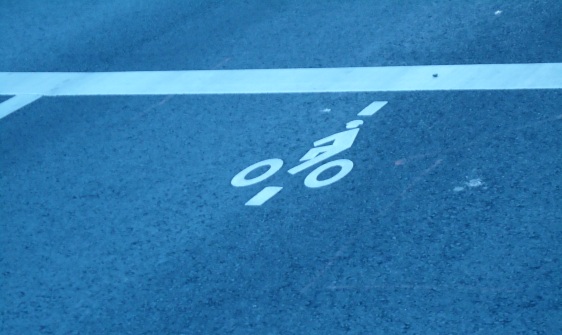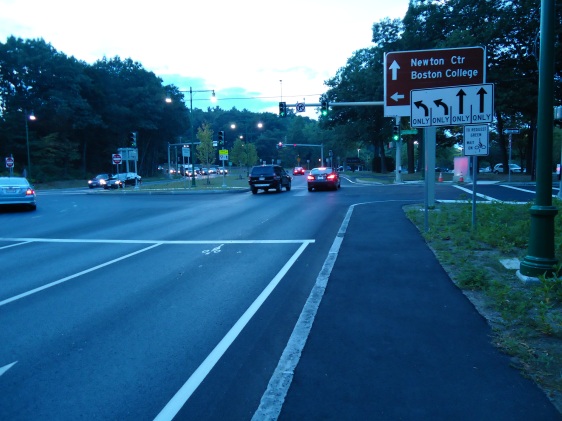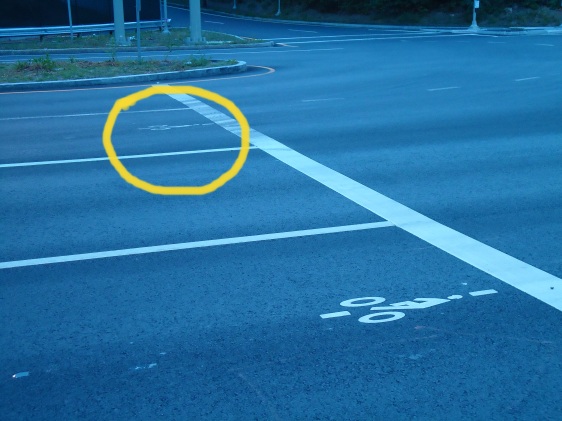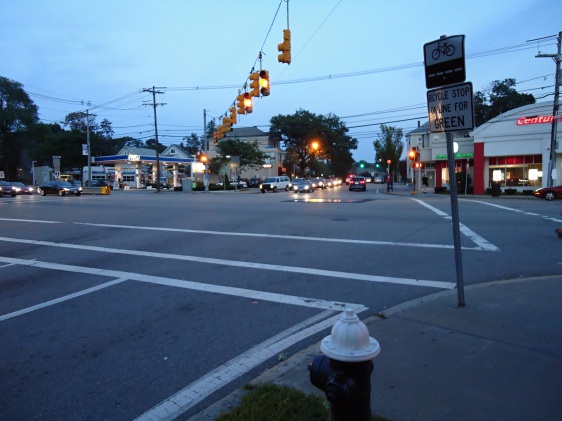
A couple of days ago, I wrote a post about the “bicycle wait on line for green signs” I have seen in the areas where I ride. For years, none of those signs have been usable because there is nothing on the road telling a cyclist where to stand in order to activate the light.
Of course, I had to complain about this since it wastes a lot of my time and energy. I can’t even count the number of times I’ve moved my bike all around the stop line at an intersection trying to get the light to turn green. Usually, I end up going through the red light out of frustration.
Almost as soon as I wrote my post on this subject, transportation planners/designers and traffic engineers came out of the woodwork to enlighten us about the regulations concerning the placement and use of the bicycle signal activation signs. I kid you not! Well, actually, they were also cyclists, although, since I don’t know them, I’m not sure how they found my blog.
I was glad to learn about such matters. My work has nothing to do with designing or building roads so I’ve never gone to the trouble to look up the regulations governing the use of traffic signs. I guess I could be called an “end-user” of such signs.
I must say that I was very impressed by the quality of the comments these people left, so much so that I thought they deserved a post of their own. I will share them with you below.
First, a member of the National (NCUTCD) Bicycle Technical Committee and California Traffic Control Devices Committee (CTCDC) left a comment.
“The ‘To Request Green, Wait on [picture of bicycle straddling a line]’ sign is the US standard R10-22 “Bicycle Signal Activation sign”, defined and described in FHWA’s Manual on Uniform Traffic Control Devices (MUTCD), Section 9B.13. However, to be most effective the sign should be accompanied by a pavement marking — also standardized in the MUTCD — that shows where to wait (on an inductive detector loop, or in the area of the lane that is best for being detected by a video image detector camera). That marking, called the Bicycle Detector Symbol, is described in MUTCD Section 9C.05 and depicted in MUTCD Figure 9C-7. It consists of two “tire tracks” showing where to place your wheels, with a bicyclist icon between.
Note that the device and section names follow MUTCD-speak and so can be misleading. Thus:
* The R10-22 sign is not just for use at Bicycle Signals (which are in California’s MUTCD but not yet in the US MUTCD)
* The marking is not just for detectors specific to bicycles, as might be present in a bike lane, and not just for inductive (loop) detectors.
The US (FHWA) MUTCD is on the web. MUTCD Part 9 includes many bicycle-related devices (signs, markings, and someday signals):
http://mutcd.fhwa.dot.gov/htm/2009/part9/part9_toc.htm
John Ciccarelli
Bicycle Solutions
San Francisco
Member, National (NCUTCD) Bicycle Technical Committee
Member, California Traffic Control Devices Committee (CTCDC)”
When I pointed out that we don’t have the street markings in Massachusetts he replied:
“That’s why the MUTCD Section reads, in its entirety:
– – – – –
Section 9B.13 Bicycle Signal Actuation Sign (R10-22)
Option:
01 The Bicycle Signal Actuation (R10-22) sign (see Figure 9B-2) may be installed at signalized intersections where markings are used to indicate the location where a bicyclist is to be positioned to actuate the signal (see Section 9C.05).
Guidance:
02 If the Bicycle Signal Actuation sign is installed, it should be placed at the roadside adjacent to the marking to emphasize the connection between the marking and the sign.
– – – – –
The “U” in MUTCD is “Uniform”. The reason so many volunteer practitioners stay engaged in the (long, drawn-out, at times glacial) collaborative, debate-laden process of adding TCDs (Traffic Control Devices) to the Manual is that a well-designed device with effective application guidance — along with state and local agencies that understands and applies it correctly — really does enhance traveler understanding and experience, and hopefully safety.
MUTCD section 1A.02, Principles of Effective Traffic Control Devices, says:
– – – – –
To be effective, a traffic control device should meet five basic requirements:
Fulfill a need;
Command attention;
Convey a clear, simple meaning;
Command respect from road users; and
Give adequate time for proper response.
– – – – –
“Homebrew” signs, markings and signals — however well-intentioned — often fall short.
John Ciccarelli
Bicycle Solutions”
Very interesting. It’s worth clicking on the link to these regulations just to see how complex all of it is. No wonder the road planners in Massachusetts ignore the rules.
Another commenter came along who is a traffic engineer and member of the National Committee on Uniform Traffic Control Devices (NCUTCD), representing the League of American Bicyclists. He provided additional information.
“When the Bicycle Technical Committee of the National Committee on Uniform Traffic Control Devices (NCUTCD) first proposed a bicycle detection sign in the late 1990s, no less than six different designs (using different layouts and messages) were proposed, tested, evaluated, and discarded (due to unintended messages or inability to convey a clear message) before developing the sign design that is now the R10-22 in the US MUTCD (seen in the uppermost photo). It’s dismaying that agencies have chosen not to use the national sign, and are creating non-standard signs that, as noted above, can lead to confusion.
Some states and local agencies have modified their laws to state that a traffic signal that fails to detect or change for a road user after a specific period of time may be treated as “malfunctioning”, and can allow a movement after a full stop and if no conflicting traffic is present. But many states and other jurisdictions haven’t recognized this in their laws.
Richard C. Moeur”
Can you imagine? Six different designs were proposed and evaluated for the “bicycles stop on the line to trigger green light” signs. They chose one that I’d never seen until I stumbled upon the one in the photo at the top of my last blog post.
In response to my comments about the confusion caused by the different sign designs and my never having seen the pavement markings, he said the following:
“This is precisely why it took so many iterations to get the R10-22 sign – making up legends or layouts for this sign will likely result in confusion – as will installing the sign without the corresponding marking (see http://mutcd.fhwa.dot.gov/htm/2009r1r2/part9/part9c.htm#figure9C07).”
I read through the regulations and learned quite a few things I didn’t know before. But, what was more interesting than my reading session was what happened when I was on my way to Boston College the other day.
I traveled down the same road where I had seen the new vertical signs when an amazing sight befell me: someone had come back to the same spot where I saw the vertical line sign and painted the bicycle markings on the road. Unbelievable! Not here in Massachusetts! Properly installed road signs are nothing short an anomaly.
Here are a few pictures of what I found:


Strangely enough, on the other side of the shopping center where these new signs and road markings appeared is the old type of sign with no road markings. I don’t know why they left it that way when they replaced the crosswalk buttons and lights at that intersection. Perhaps it was too much trouble to paint the markings or the sensors at the intersection aren’t sensitive enough to detect a bicycle.

Slowly but surely Massachusetts is catching up with the regulations. All right, very slowly is more accurate. This is the only road of its type in the area. Too bad they didn’t see fit to install bike lanes on the newly redesigned road. I guess we’ll have to settle for nationally approved bike signs and accompanying pavement markings instead.



